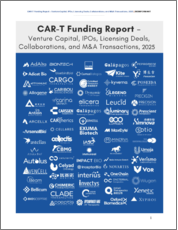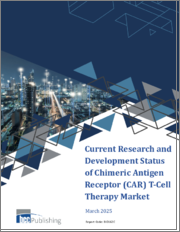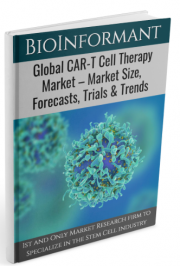
|
시장보고서
상품코드
1625427
CAR-T 세포 치료 시장 규모, 점유율, 동향, 산업 분석 보고서 : 적응증별, 표적 항원별, 지역별 - 시장 예측(2025-2034년)CAR-T Cell Therapy Market Size, Share, Trends, Industry Analysis Report: By Indication, Target Antigen, and Region (North America, Europe, Asia Pacific, Latin America, and Middle East & Africa) - Market Forecast, 2025-2034 |
||||||
Polaris Market Research의 최신 조사에 따르면, 세계 CAR-T 세포 치료 시장 규모는 2034년까지 1,888억 4,000만 달러에 달할 것으로 예상됩니다. 이 보고서는 현재 시장 역학에 대한 자세한 인사이트와 향후 시장 성장에 대한 분석을 제공합니다.
키메라 항원 수용체 T세포(CAR-T) 치료는 암 치료의 진보를 상징하며 면역종양학의 판도를 바꾸어 놓았습니다. 이 치료법은 특정 암 항원을 표적으로 하는 합성 수용체를 발현하도록 환자의 T 세포를 조작하여 특정 암, 특히 혈액 악성 종양에 대해 개별화되고 매우 효과적인 치료 옵션을 제공합니다. 세계 CAR-T 세포 치료 시장은 생명공학 기술의 급속한 발전, CAR-T 치료제의 승인률 증가, 혁신적인 암 치료제에 대한 수요 증가 등에 힘입어 지난 10년간 급격한 성장세를 보이고 있습니다.
전 세계적으로 암 발병률이 증가하고 정밀의료에 대한 선호도가 높아지면서 CAR-T 세포 치료와 같은 첨단 치료법에 대한 수요가 증가하고 있습니다. 또한, 지원적인 규제 프레임워크와 신속한 승인 경로가 CAR-T 치료제의 가용성을 가속화하고 있습니다. 정부 및 민간 연구 투자는 CAR-T 세포 치료 시장 확대를 더욱 촉진하고 있습니다.
다중 표적 CAR-T 세포와 아머드 CAR-T 세포를 포함한 차세대 CAR-T 치료제의 개발이 CAR-T 세포 치료 시장의 성장을 촉진하고 있습니다. 다중 표적 CAR-T 세포는 여러 항원을 인식하도록 설계되어 기존 CAR-T 치료의 효능을 제한하는 종양 불균일성 및 항원 회피와 같은 문제를 해결합니다. 무장 CAR-T 세포는 사이토카인 및 기타 분자를 분비하여 항종양 활성을 증가시킴으로써 면역억제 종양 미세환경을 극복하도록 설계되었습니다.
CAR-T 치료의 적용은 종양학 외에도 확대되고 있습니다. 연구자들은 루푸스, 다발성 경화증과 같은 자가면역질환과 HIV와 같은 감염성 질환의 치료 가능성을 모색하고 있습니다. 이러한 새로운 응용 분야는 시장의 범위와 영향력을 크게 확대할 것으로 예상됩니다.
CAR-T 세포 치료 시장 보고서 하이라이트
적응증별로는 여포성 림프종(FL) 분야가 가장 빠른 속도로 성장할 것으로 예상되며, 예측 기간 동안 43.2%의 CAGR을 기록할 것으로 예상됩니다.
표적 항원별로 보면 CD19/CD22 항원 부문은 미만성 대세포 B세포 림프종(DLBCL) 및 급성 림프아구성 백혈병(ALL)과 같은 B세포 악성 종양 치료에서 확립된 역할로 인해 2024년 6조 2,585억 달러로 가장 큰 시장 점유율을 차지했습니다.
세계 시장에서 북미 CAR-T 세포 치료 시장은 2024년 47.16%의 시장 점유율을 차지했습니다. 이는 높은 수준의 의료 인프라, 막대한 R&D 투자, 혈액 악성종양 유병률이 높기 때문입니다.
유럽 CAR-T 세포 치료 시장은 재발성 또는 난치성 혈액암의 유병률 증가와 첨단 치료법에 대한 접근성 확대에 대한 관심이 높아지면서 예측 기간 동안 33.2%의 CAGR을 기록할 것으로 예상됩니다.
세계 주요 시장 기업으로는 Bluebird Bio, Celgene Corporation, Gilead Sciences, Cellectis, Servier Laboratories, Pfizer Inc., Merck, Amgen, Intellia Therapeutics, Novartis, Caribou Biosciences, Celyad, Bellicum Pharmaceuticals, Noile-Immune Biotech, Nanjing Legend Biotechnology Co. 등이 있습니다.
목차
제1장 소개
- 보고서 설명
- 연구 목적
- 시장 범위
- 가정
- 이해관계자
- 약어 리스트
제2장 주요 요약
- 시장 하이라이트
제3장 조사 방법
- 개요
- 데이터 마이닝
- 데이터 소스
- 1차 정보
- 2차 정보
제4장 CAR-T 세포 치료 시장 인사이트
- CAR-T 세포 치료 시장 역학
- 성장 촉진요인과 기회
- DLBCL와 다발성 골수종 신약 발매도 함께 백혈병 분야에서 유망한 성장
- 고형 종양에 대한 응용의 가능성
- 성장 억제요인과 과제
- 환자 재발
- 제조와 물류 과제
- 경제 모델/상환/스케일링
- 성장 촉진요인과 기회
- PEST 분석
- CAR-T 세포 치료 개발 타임라인
- CAR-T 세포 제조 전망
- CAR-T 세포의 부작용
- 고형 종양을 표적으로 하는 항원
- CAR-T 임상시험 상황
- 상업 상황(인수합병, 파트너십과 협업)
- CAR-T 요법의 새로운 혁신
- "기성" CAR-T 또는 동종 CAR-T
- 듀얼 CAR-T 개발
- 비바이러스 전사 기술 개발
- TIL와 TCR 요법의 등장
- TCR(T세포 수용체)
- TIL(종양침윤림프구)
- 코로나 영향 분석
- 맞춤형 - CAR-T 세포 시장
제5장 CAR-T 세포 치료 시장 평가 : 적응증별
- 소개
- DLBCL
- ALL
- CLL
- MM
- FL
- 비만세포증
- 골수섬유증
- MLLL
- 흉선암
- 신경 교모세포종
- AML
- 기타 적응증
제6장 세계의 CAR-T 세포 치료 시장 : 표적 항원별
- 소개
- CD19/CD22
- BCMA
- 기타
제7장 CAR-T 세포 치료 시장 평가 : 지역별
- 소개
- 북미
- 미국
- 캐나다
- 유럽
- 독일
- 영국
- 프랑스
- 이탈리아
- 스페인
- 네덜란드
- 오스트리아
- 아시아태평양
- 중국
- 인도
- 일본
- 한국
- 호주
- 라틴아메리카
- 브라질
- 멕시코
- 중동 및 아프리카
- 사우디아라비아
- 아랍에미리트
제8장 경쟁 구도
- 제품 발매와 인수는 기업에서 가장 많이 채용되고 있는 전략이다
- 제품 발매
- 제휴/협업/합의/공개
제9장 기업 개요
- Bluebird Bio
- 기업 개요
- 재무 실적
- 제품 벤치마크
- 최근의 개발
- Celgene Corporation
- 기업 개요
- 재무 실적
- 제품 벤치마크
- 최근의 개발
- Gilead Sciences, Inc.
- 기업 개요
- 재무 실적
- 제품 벤치마크
- 최근의 개발
- Cellectis
- 기업 개요
- 재무 실적
- 제품 벤치마크
- 최근의 개발
- Servier Laboratories
- 기업 개요
- 재무 실적
- 제품 벤치마크
- 최근의 개발
- Pfizer Inc.
- 기업 개요
- 재무 실적
- 제품 벤치마크
- 최근의 개발
- Merck KGaA
- 기업 개요
- 재무 실적
- 제품 벤치마크
- 최근의 개발
- Amgen Inc.
- 기업 개요
- 재무 실적
- 제품 벤치마크
- 최근의 개발
- Intellia Therapeutics
- 기업 개요
- 재무 실적
- 제품 벤치마크
- 최근의 개발
- Novartis International AG
- 기업 개요
- 재무 실적
- 제품 벤치마크
- 최근의 개발
- Caribou Biosciences, Inc
- 기업 개요
- 재무 실적
- 제품 벤치마크
- 최근의 개발
- Celyad
- 기업 개요
- 재무 실적
- 제품 벤치마크
- 최근의 개발
- Bellicum Pharmaceuticals, Inc.
- 기업 개요
- 재무 실적
- 제품 벤치마크
- 최근의 개발
- Noile-Immune Biotech
- 기업 개요
- 제품 벤치마크
- 최근의 개발
- Nanjing Legend Biotechnology Co., Ltd.
- 기업 개요
- 제품 벤치마크
- 최근의 개발
- Johnson & Johnson
- 기업 개요
- 재무 실적
- 제품 벤치마크
- 최근의 개발
- Sangamo Therapeutics, Inc.
- 기업 개요
- 재무 실적
- 제품 벤치마크
- 최근의 개발
The global CAR-T cell therapy market size is expected to reach USD 188.84 billion by 2034, according to a new study by Polaris Market Research. The report "CAR-T Cell Therapy Market Size, Share, Trends, Industry Analysis Report: By Indication, Target Antigen [CD19/CD22, BCMA (B-Cell Maturation Antigen), and Others], and Region (North America, Europe, Asia Pacific, Latin America, and Middle East & Africa) - Market Forecast, 2025-2034" gives a detailed insight into current market dynamics and provides analysis on future market growth.
Chimeric Antigen Receptor T-cell (CAR-T) therapy represents an advancement in cancer treatment, transforming immuno-oncology. The therapy offers personalized and highly effective treatment options for certain cancers, particularly hematological malignancies, by engineering a patient's T-cells to express synthetic receptors that target specific cancer antigens. The global CAR-T cell therapy market has witnessed exponential growth over the last decade, driven by rapid advancements in biotechnology, increasing approval rates of CAR-T therapies, and rising demand for innovative cancer treatments.
The increasing prevalence of cancer globally, coupled with a growing preference for precision medicine, has fueled demand for advanced treatment modalities such as CAR-T cell therapy. Moreover, supportive regulatory frameworks and rapid approval pathways have accelerated the availability of CAR-T therapies. Government and private investments in research further propel the CAR-T cell therapy market expansion.
The development of next-generation CAR-T therapies, including multi-target CAR-T cells and armored CAR-T cells, is driving the CAR-T cell therapy market growth. Multi-target CAR-T cells are engineered to recognize multiple antigens, addressing issues such as tumor heterogeneity and antigen escape, which limit the efficacy of traditional CAR-T treatments. Armored CAR-T cells are designed to overcome the immunosuppressive tumor microenvironment by secreting cytokines or other molecules to enhance anti-tumor activity.
The application of CAR-T therapy is expanding beyond oncology. Researchers are exploring its potential in treating autoimmune diseases such as lupus and multiple sclerosis and infectious diseases, including HIV. These novel applications are estimated to significantly broaden the market scope and impact.
CAR-T Cell Therapy Market Report Highlights
In terms of indication, the follicular lymphoma (FL) segment is expected to grow at the fastest pace, with a CAGR of 43.2% during the forecast period due to the rising incidence of refractory and high-risk cancer cases.
Based on target antigen, the CD19/CD22 antigen segment, valued at USD 6,258.5 billion in 2024, held the largest market share owing to its established role in treating B-cell malignancies such as diffuse large B-cell lymphoma (DLBCL) and acute lymphoblastic leukemia (ALL).
In the global market, the North America CAR-T cell therapy market held a 47.16% market share in 2024 due to the presence of advanced healthcare infrastructure, significant research and development investments, and a high prevalence of hematologic malignancies.
The Europe CAR-T cell therapy market is expected to witness a CAGR of 33.2% during the forecast period due to increased focus on expanding access to advanced therapies, coupled with the rising prevalence of relapsed or refractory hematologic cancers.
A few of the global key market players are Bluebird Bio; Celgene Corporation; Gilead Sciences; Cellectis; Servier Laboratories; Pfizer Inc.; Merck; Amgen; Intellia Therapeutics; Novartis; Caribou Biosciences; Celyad; Bellicum Pharmaceuticals, Inc.; Noile-Immune Biotech; Nanjing Legend Biotechnology Co., Ltd.; Johnson & Johnson; and Sangamo Therapeutics, Inc.
Polaris Market Research has segmented the CAR-T cell therapy market report on the basis of indication, antigen, and region:
By Indication Outlook (Revenue, USD Billion, 2020-2034)
- DLBCL (Diffuse large B-cell lymphoma)
- ALL (Acute Lymphoblastic Leukemia)
- CLL (Chronic Lymphocytic Leukemia)
- MM (Multiple Myeloma)
- FL (Follicular Lymphoma)
- Mastozytosis
- Myeloid Fibrosis
- MLL (Mixed Lineage Leukemia)
- Thymic Cancer
- Glioblastoma
- AML (Acute Myeloid Leukemia)
- Other
By Target Antigen Outlook (Revenue, USD Billion, 2020-2034)
- CD19/CD22
- BCMA (B-Cell Maturation Antigen)
- Others
By Regional Outlook (Revenue, USD Billion, 2020-2034)
- North America
- US
- Canada
- Europe
- Germany
- France
- UK
- Italy
- Spain
- Netherlands
- Russia
- Rest of Europe
- Asia Pacific
- China
- Japan
- India
- Malaysia
- South Korea
- Indonesia
- Australia
- Vietnam
- Rest of Asia Pacific
- Middle East & Africa
- Saudi Arabia
- UAE
- Israel
- South Africa
- Rest of Middle East & Africa
- Latin America
- Mexico
- Brazil
- Argentina
- Rest of Latin America
Table of Contents
Chapter 1. Introduction
- 1.1 Report Description
- 1.1.1 Objectives of the Study
- 1.1.2 Market Scope
- 1.2 Assumptions
- 1.3 Stakeholders
- 1.4 List of Abbreviations
Chapter 2. Executive Summary
- 2.1 Market Highlights
Chapter 3. Research Methodology
- 3.1 Overview
- 3.1.1 Data Mining
- 3.2 Data Sources
- 3.2.1 Primary Sources
- 3.2.2 Secondary Sources
Chapter 4. CAR-T Cell Therapy Market Insights
- 4.1 CAR-T Cell Therapy Market Dynamics
- 4.1.1 Drivers and Opportunities
- 4.1.1.1 Promising growth in leukemia segment for DLBCL and Multiple Myeloma coupled with launches
- 4.1.1.2 Potential applications in solid tumor
- 4.1.2 Restraints and Challenges
- 4.1.2.1 Patient Relapse
- 4.1.2.2 Manufacturing and logistics challenges
- 4.1.2.3 Economic model/reimbursement/scaling
- 4.1.1 Drivers and Opportunities
- 4.2 Porter's Five Forces Analysis
- 4.2.1 Bargaining Power of Suppliers (High)
- 4.2.2 Threats of New Entrants: (High)
- 4.2.3 Bargaining Power of Buyers (Low)
- 4.2.4 Threat of Substitute (Low)
- 4.2.5 Rivalry among existing firms (High)
- 4.3 PEST Analysis
- 4.4 Timeline of CAR-T Cell Therapy Development
- 4.5 CAR-T Cell Manufacturing Outlook
- 4.6 Side-effects of CAR-T Cell
- 4.7 Antigens targeting solid tumors
- 4.8 Clinical trials Landscape for CAR-T
- 4.9 Commercial Landscape (Mergers & Acquisitions, Partnerships & Collaborations)
- 4.10 New Innovations in CAR-T therapies
- 4.10.1 "Off-the-shelf" CAR-T or allogenic CAR-T
- 4.10.2 Development of Dual CAR-T
- 4.10.3 Development of Non-viral transcription technologies
- 4.10.4 The advent of TIL as well as TC R therapies
- 4.10.4.1 TCR (T-cell receptor)
- 4.10.4.2 TIL (Tumor-Infiltrating Lymphocytes)
- 4.11 CAR-T Cell Therapy Market - Covid Impact Analysis
- 4.12 Customization - CAR-T Cell Market
Chapter 5. CAR-T Cell Therapy Market Assessment by Indication
- 5.1 Introduction
- 5.2 DLBCL
- 5.3 ALL
- 5.4 CLL
- 5.5 MM
- 5.6 FL
- 5.7 Mastozytosis
- 5.8 Myeloid Fibrosis
- 5.9 MLL
- 5.10 Thymic Cancer
- 5.11 Glioblastoma
- 5.12 AML
- 5.13 Other Indications
Chapter 6. Global CAR-T Cell Therapy Market, by Target Antigen
- 6.1 Introduction
- 6.2 CD19/CD22
- 6.3 BCMA
- 6.4 Others
Chapter 7. CAR-T Cell Therapy Market Assessment by Geography
- 7.1 Introduction
- 7.2 CAR-T Cell Therapy Market - North America
- 7.2.1 CAR-T Cell Therapy Market - U.S.
- 7.2.2 CAR-T Cell Therapy Market - Canada
- 7.3 CAR-T Cell Therapy Market - Europe
- 7.3.1 CAR-T Cell Therapy Market - Germany
- 7.3.2 CAR-T Cell Therapy Market - UK
- 7.3.3 CAR-T Cell Therapy Market - France
- 7.3.4 CAR-T Cell Therapy Market - Italy
- 7.3.5 CAR-T Cell Therapy Market - Spain
- 7.3.6 CAR-T Cell Therapy Market - Netherlands
- 7.3.7 CAR-T Cell Therapy Market - Austria
- 7.4 CAR-T Cell Therapy Market - Asia Pacific
- 7.4.1 CAR-T Cell Therapy Market - China
- 7.4.2 CAR-T Cell Therapy Market - India
- 7.4.3 CAR-T Cell Therapy Market - Japan
- 7.4.4 CAR-T Cell Therapy Market - South Korea
- 7.4.5 CAR-T Cell Therapy Market - Australia
- 7.5 CAR-T Cell Therapy Market - Latin America
- 7.5.1 CAR-T Cell Therapy Market - Brazil
- 7.5.2 CAR-T Cell Therapy Market - Mexico
- 7.6 CAR-T Cell Therapy Market - Middle East & Africa
- 7.6.1 CAR-T Cell Therapy Market - Saudi Arabia
- 7.6.2 CAR-T Cell Therapy Market - UAE
Chapter 8. Competitive Landscape
- 8.1 Product Launch and Acquisition Are the Best Adopted Strategy by the Companies
- 8.2 Product Launch
- 8.3 Partnerships/Collaborations/Agreements/Exhibitions
Chapter 9. Company Profiles
- 9.1 Bluebird Bio
- 9.1.1 Company Overview
- 9.1.2 Financial Performance
- 9.1.3 Product Benchmarking
- 9.1.4 Recent Development
- 9.2 Celgene Corporation
- 9.2.1 Company Overview
- 9.2.2 Financial Performance
- 9.2.3 Product Benchmarking
- 9.2.4 Recent Development
- 9.3 Gilead Sciences, Inc.
- 9.3.1 Company Overview
- 9.3.2 Financial Performance
- 9.3.3 Product Benchmarking
- 9.3.4 Recent Development
- 9.4 Cellectis
- 9.4.1 Company Overview
- 9.4.2 Financial Performance
- 9.4.3 Product Benchmarking
- 9.4.4 Recent Development
- 9.5 Servier Laboratories
- 9.5.1 Company Overview
- 9.5.2 Financial Performance
- 9.5.3 Product Benchmarking
- 9.5.4 Recent Development
- 9.6 Pfizer Inc.
- 9.6.1 Company Overview
- 9.6.2 Financial Performance
- 9.6.3 Product Benchmarking
- 9.6.4 Recent Development
- 9.7 Merck KGaA
- 9.7.1 Company Overview
- 9.7.2 Financial Performance
- 9.7.3 Product Benchmarking
- 9.7.4 Recent Development
- 9.8 Amgen Inc.
- 9.8.1 Company Overview
- 9.8.2 Financial Performance
- 9.8.3 Product Benchmarking
- 9.8.4 Recent Development
- 9.9 Intellia Therapeutics
- 9.9.1 Company Overview
- 9.9.2 Financial Performance
- 9.9.3 Product Benchmarking
- 9.9.4 Recent Development
- 9.10 Novartis International AG
- 9.10.1 Company Overview
- 9.10.2 Financial Performance
- 9.10.3 Product Benchmarking
- 9.10.4 Recent Development
- 9.11 Caribou Biosciences, Inc
- 9.11.1 Company Overview
- 9.11.2 Financial Performance
- 9.11.3 Product Benchmarking
- 9.11.4 Recent Development
- 9.12 Celyad
- 9.12.1 Company Overview
- 9.12.2 Financial Performance
- 9.12.3 Product Benchmarking
- 9.12.4 Recent Development
- 9.13 Bellicum Pharmaceuticals, Inc.
- 9.13.1 Company Overview
- 9.13.2 Financial Performance
- 9.13.3 Product Benchmarking
- 9.13.4 Recent Development
- 9.14 Noile-Immune Biotech
- 9.14.1 Company Overview
- 9.14.2 Product Benchmarking
- 9.14.3 Recent Development
- 9.15 Nanjing Legend Biotechnology Co., Ltd.
- 9.15.1 Company Overview
- 9.15.2 Product Benchmarking
- 9.15.3 Recent Development
- 9.16 Johnson & Johnson
- 9.16.1 Company Overview
- 9.16.2 Financial Performance
- 9.16.3 Product Benchmarking
- 9.16.4 Recent Development
- 9.17 Sangamo Therapeutics, Inc.
- 9.17.1 Company Overview
- 9.17.2 Financial Performance
- 9.17.3 Product Benchmarking
- 9.17.4 Recent Development



















